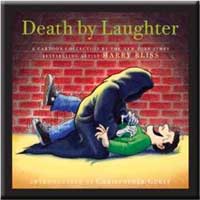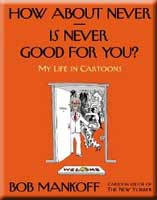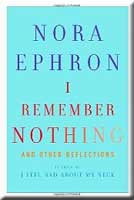
|
SXM-Info
Online Bookstore
|

|
|
Jump to:
Food, Wine, and Cooking |
History |
Humor |
Investment |
Island |
Mysteries |
Novels |
Science & Nature |
Travel |
CDs
Search all of Amazon |
SXM-Info Home Page
Books on Humor
|
Death by Laughter by Harry Bliss - about $15 - From Amazon: Welcome to the world of Harry Bliss, a New York Times bestselling cartoonist whose gag cartoons look at the world in a fresh, twisted, and unique way. Each panel is a sharp and smart look at the paradoxes of life, ranging from lust and love to misfortune and bitterness. Bliss's cartoons expose truths so human, so real, they're timeless. However, time is running out in Death by Laughter, a collection of cartoons about death, fatality, and "the examined life" that Socrates referred to (only his gags weren't illustrated or, frankly, all that funny). Sheer Bliss."
Harry Bliss is the New York Times bestselling artist of Diary of a Fly, Diary of a Spider, and Diary of a Worm by Doreen Cronin; A Fine, Fine School by Sharon Creech; and Which Would You Rather Be? by William Steig. He is also an award-winning cartoonist and a cover artist for The New Yorker. He was a Sendak Fellow, spending about a month here in Salem, NY at a nearby farm that used to belong to Maurice. He and his fellow Fellow, Nora Krug, came over for dinner one evening. He left us a copy of this collection.
|
|

|
|
How About Never--Is Never Good for You?: My Life in Cartoons [Kindle Edition] by Bob Mankoff - about $17 - From Amazon: People tell Bob Mankoff that as the cartoon editor of The New Yorker he has the best job in the world. Never one to beat around the bush, he explains to us, in the opening of this singular, delightfully eccentric book, that because he is also a cartoonist at the magazine he actually has two of the best jobs in the world. With the help of myriad images and his funniest, most beloved cartoons, he traces his love of the craft all the way back to his childhood, when he started doing funny drawings at the age of eight. After meeting his mother, we follow his unlikely stints as a high-school basketball star, draft dodger, and sociology grad student. Though Mankoff abandoned the study of psychology in the seventies to become a cartoonist, he recently realized that the field he abandoned could help him better understand the field he was in, and here he takes up the psychology of cartooning, analyzing why some cartoons make us laugh and others don't. He allows us into the hallowed halls of The New Yorker to show us the soup-to-nuts process of cartoon creation, giving us a detailed look not only at his own work, but that of the other talented cartoonists who keep us laughing week after week. For dessert, he reveals the secrets to winning the magazine's caption contest. Throughout How About Never--Is Never Good for You?, we see his commitment to the motto "Anything worth saying is worth saying funny."
|
|

|
|
I Remember Nothing by Nora Ephron - about $14 - Nora says: I have a book coming out called I Remember Nothing, and it will probably not surprise you to hear that I can't recall how I came to write it.
I notice that most authors who write about their books on their Amazon page know exactly when inspiration struck, and they describe this Eureka moment quite eloquently. But I don't have a clue about mine. There had to have been a blinding flash when I realized I had to write something about Age and Memory, but, as I said, I remember nothing, and my guess is that this shimmering insight was followed in short order by my forgetting I'd had the idea in the first place. And then I had the idea again. And forgot it again. Until finally, miraculously, it stuck.
When you're young, you make jokes about how things slip your mind. You think it's amusing that you've wandered into the kitchen and can't remember why. Or that you carefully made a shopping list and left it home on the counter. Or that you managed to forget the plot of a movie you saw only last week.
And then you get older.
|
|

|
|
A couple of years ago, the actor Ryan O'Neal failed to recognize his own daughter Tatum at a funeral and accidentally made a pass at her. Everyone was very judgmental about this, but not me: only a few weeks earlier, I'd been in a mall in Las Vegas when a very pleasant-looking woman came toward me, her arms outstretched, and I thought to myself, who is this woman? How do I know her? It turned out to be my sister Amy. You might think, well, how was she to know her sister was in Las Vegas, but I'm sorry to say that not only did I know, but she was the person I was meeting in the mall.
Anyway, at some point, I thought it might be fun to write a book about what I remember, and what I've forgotten. I still feel bad about my neck, but I feel even worse about the fact that huge bits of my life have gone slip-sliding away, and I thought I'd better write them down while I still had a sense of humor about it all.
|
|
I'm a Stranger Here Myself: Notes on Returning to America After 20 Years Away by Bill Bryson - about $11 for a paperback -
From Amazon (Melissa Rossi): In the world of contemporary travel writing, Bill Bryson often emerges as a major contender for King of Crankiness. Granted, he complains well and humorously, but between every line of his travel books you can almost hear the tinny echo: "I wanna go home, I miss my wife." Happily, I'm a Stranger Here Myself unleashes a new Bryson, more contemplative and less likely to toss daggers. After two decades in England, he's relocated to Hanover, New Hampshire. In this collection (drawn from dispatches for London's Night & Day magazine), he's writing from home, in close proximity to wife and family. We find a happy marriage between humor and reflection as he assesses life both in New England and in the contemporary United States. With the telescopic perspective of one who's stepped out of the American mainstream and come back after 20 years, Bryson aptly holds the mirror up to U.S. culture, capturing its absurdities--such as hotlines for dental floss, the cult of the lawsuit, and strange American injuries such as those sustained from pillows and beds. "In the time it takes you to read this," he writes, "four of my fellow citizens will somehow manage to be wounded by their bedding."
|
|

|
The book also reflects the sweet side of small-town USA, with columns about post-office parties, dining at diners, and Thanksgiving--when the only goal is to "get your stomach into the approximate shape of a beach ball" and be grateful. And grateful we are that the previously peripatetic Bryson has returned to the U.S., turning his eye to this land--while living at home and near his wife. Under her benevolent influence, he entertains through thoughtful insights, not sarcastic stabs
|





